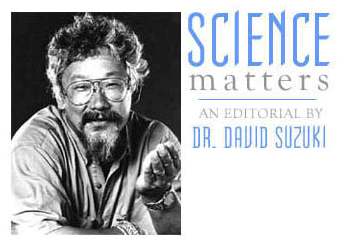| 破坏环境容易,恢复却很难
把地球表面搞得一团糟是一件非常容易的事情,但是恢复却耗时耗力——大多数的加拿大人已经习惯自己生活在一种快速的节奏中。人们使用移动电话以便能够快速及时的联系。人们使用email以便能够在眨眼之间发送传真和照片。我们选择快餐是因为吃快餐的话可以不用等候。……一旦作出任何决定就想立即看见结果。
http://www.enn.com/news/2004-01-29/s_12569.asp
Messing up a planet is easy, fixing
it takes time
Thursday, January 29, 2004
By David Suzuki
Most Canadians are used to life moving at break-neck speed.
We carry cell phones so we can be reached instantly. We use
email so we can transmit text and photos in the blink of an
eye. We eat at fast food chains so we can get our food immediately.
We drive everywhere to get there faster. Once we've made a
decision, we want results — now.
Unfortunately, the rest of life on our planet
doesn't work that way. Things take time. Processes evolve
over hundreds, thousands, or millions of years. As a result,
humanity has no problem messing things up quickly but little
patience when it comes to fixing them.
A perfect example is the ozone layer. Nearly
20 years ago, scientists discovered a massive hole in the
ozone layer, the protective layer of ozone gas high in the
atmosphere that helps shield all living things from the Sun's
harsh rays. The hole was growing and threatened to cause increased
skin cancer in humans and a host of unknown environmental
problems.
Over the next few years, scientists determined
the cause of the problem: a group of chemical compounds called
CFCs that were used in solvents, aerosols, and as coolants
in refrigeration units and air conditioners. When CFCs find
their way up into the stratosphere and react with ultraviolet
light, it creates chlorine free radicals, which are potent
scavengers of ozone. In an unprecedented move, nations around
the world quickly agreed to phase out CFCs and the Montreal
Protocol was born.
It is a well-known and unqualified success.
As one researcher points out in a recent edition of the journal
Nature, even schoolchildren today are familiar with the story.
Unfortunately, our instant-fix mentality is so ingrained that
many people are still confused when stories about the ozone
hole continue to appear every year. "Didn't we fix that?"
is a common refrain.
In fact, the Montreal Protocol is working. CFC
production has dropped to near zero levels and the ozone layer
seems to be gradually repairing itself. But CFCs can persist
in the atmosphere for 50 to 100 years. So some of the CFCs
manufactured 40 years ago are still destroying ozone today.
It will take decades before the protective layer fully heals.
Until then, the size of the hole will fluctuate from year
to year.
Another class of chemicals that will continue
to haunt us for decades, even though a number of them were
banned in 2001, are persistent organic pollutants. These toxic
chemical compounds, which include PCBs, DDT, and dioxin, are
easily transported by air and ocean currents and have found
their way into even the most remote regions of the planet.
They did not exist 75 years ago, but today traces of these
compounds can be found in the bodies of every person on Earth.
No one knows what long-term effect these substances are having
on our health.
As humanity's influence on the environment and
natural systems continues to grow, we have to remember that
it can take far longer to solve our problems than it does
to create them. We cannot just switch a problem off like a
remote-control television. Global warming, for example, will
not be solved instantly. The carbon dioxide we are pumping
into the atmosphere today will stay in our air for several
hundred years. Even if we stopped producing heat-trapping
gases today, the Earth will continue to warm, and we will
continue to have more extreme weather events and other climate-related
problems for generations.
That's why it's so important to get started
now. Our planet cannot be commanded to fix itself. Mother
Nature does not have a cell phone. She doesn't use email,
and she's not too keen on instant messaging either. She takes
her time, and we'd better get used to it because like it or
not, we're on her schedule.
Take the Nature Challenge and learn more at
www.davidsuzuki.org
Source: David Suzuki Foundation
|


